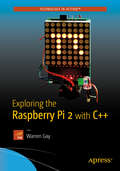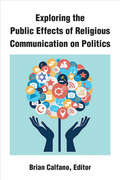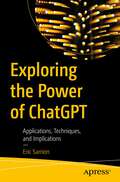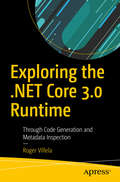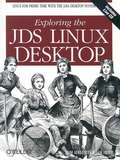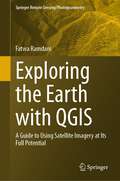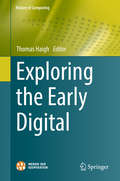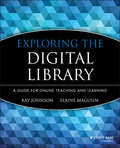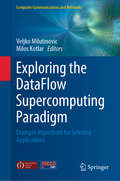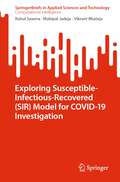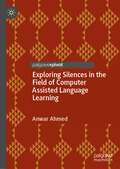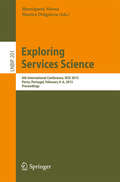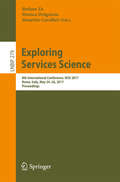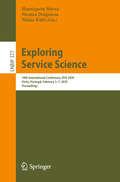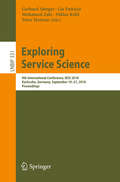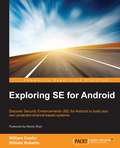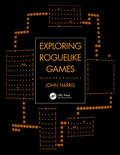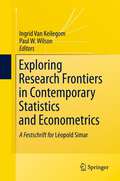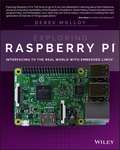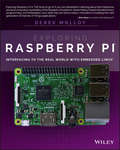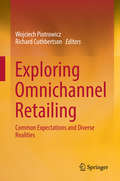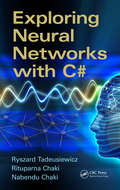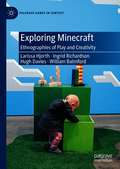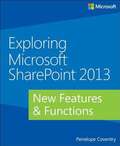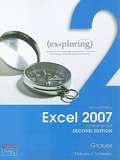- Table View
- List View
Exploring the Raspberry Pi 2 with C++
by Warren GayYou have a Pi 2, but what exactly can you do with it? This book takes you on a tour of the Pi 2 hardware and all of the fantastic things that you can do to create innovative and useful projects with your Pi. Start with creating a workstation that does actual work, and move into installing a custom kernel, creating a clock, learning the ins and outs of the GPIO interface, and pick up some useful C++ skills along the way. Warren Gay, author of Mastering the Raspberry Pi, takes you through a set of experiments to show just what the Pi 2 is capable of and how you can use it to make your own fantastic creations. What you'll learn How to create an experimenter's workstation for the Pi 2, complete with breadboard and even Arduino All the details of GPIO, including a custom command for working with it Useful projects like a general purpose clock and the PiSpy Quick intro to C++ for the Pi How to make a multi-core webserver Who this book is for Intermediate electronics enthusiasts and Pi fans, makers, students, teachers, and everyone who wants to know how to make the Pi really work. Table of Contents Chapter 1: Introduction to Raspberry Pi 2 Chapter 2: Building Your Pi 2 Experimental Workstation Chapter 3: Installing Software for Experiments Chapter 4: Warming up with GPIO Chapter 5: Using the PWM Peripheral Chapter 6: Building a "Matrix" Display for CPU Usage Chapter 7: Using General Purpose Clocks to Send FM Signals Chapter 8: Debouncing Chapter 9: Morse Code Decoder Chapter 10: Converting Digital to Analog Chapter 11: Converting Analog to Digital Chapter 12: Building an RF Transmitter and Receiver Chapter 13: Linking the Pi to AVR or Arduino
Exploring the Public Effects of Religious Communication on Politics
by Brian CalfanoThough not all people are religious believers, religion has played important historic roles in developing political systems, parties, and policies—affecting believers and nonbelievers alike. This is particularly true in the United States, where scholars have devoted considerable attention to a variety of political phenomena at the intersection of religious belief and identity, including social movements, voting behavior, public opinion, and public policy. These outcomes are motivated by “identity boundary-making” among the religiously affiliated. The contributors to this volume examine two main factors that influence religious identity: the communication of religious ideas and the perceptions of people (including elites) in communicating said ideas. Exploring the Public Effects of Religious Communication on Politics examines an array of religious communication phenomena. These include the media’s role in furthering religious narratives about minority groups, religious strategies that interest groups use to advance their appeal, the variable strength of Islamophobia in cross-national contexts, what qualifies as an “evangelical” identity, and clergy representation of religious and institutional teachings. The volume also provides ways for readers to think about developing new insights into the influence religious communication has on political outcomes.
Exploring the Power of ChatGPT: Applications, Techniques, and Implications
by Eric SarrionLearn how to use the large-scale natural language processing model developed by OpenAI: ChatGPT. This book explains how ChatGPT uses machine learning to autonomously generate text based on user input and explores the significant implications for human communication and interaction.Author Eric Sarrion examines various aspects of ChatGPT, including its internal workings, use in computer projects, and impact on employment and society. He also addresses long-term perspectives for ChatGPT, including possible future advancements, adoption challenges, and considerations for ethical and responsible use. The book starts with an introduction to ChatGPT covering its versions, application areas, how it works with neural networks, NLP, and its advantages and limitations. Next, you'll be introduced to applications and training development projects using ChatGPT, as well as best practices for it. You'll then explore the ethical implications of ChatGPT, such as potential biases and risks, regulations, and standards. This is followed by a discussion of future prospects for ChatGPT. The book concludes with practical use case examples, such as text content creation, software programming, and innovation and creativity.This essential book summarizes what may be one of the most significant developments in artificial intelligence in recent history and provides useful insights for researchers, policymakers, and anyone interested in the future of technology.What You Will LearnUnderstand the basics of deep learning and text generation using language models such as ChatGPTPrepare data and train a language model to generate textUse ChatGPT for various applications such as marketing text generation or answering questionsUnderstand the use of ChatGPT through the OpenAI API and how to optimize model performanceWho This Book Is ForSoftware developers and professionals, researchers, students, and people interested in learning more about this field and the future of technology.
Exploring the .NET Core 3.0 Runtime: Through Code Generation and Metadata Inspection
by Roger VillelaExplore advanced .NET APIs and create a basic .NET core library with dynamic code generation and metadata inspection to be used by other libraries or client applications. This book starts with the benefits of .NET including its fundamental tasks and tools where you will learn .NET SDK tools and the ILDasm tool. This is followed by a detailed discussion on code generation in .NET API programming. Along the way, you will learn how to build a programming model through a code-generator tool and metadata inspector tool using .NET version information for .NET assembly and binary code. Exploring the .NET Core 3.0 Runtime covers the features of Microsoft Visual Studio 2019 using a tutorial and shows you how to create a .NET Core 3.0 application. Here you will configure and deploy your .NET projects along with meta packages and see some do's and don'ts. Finally, you will compare the features of .NET Core 3.0 with the .NET Framework library and its GUI frameworks. After reading this book, you will be able to work in a .NET 3.0 environment and program for its two advanced features: code generation and metadata inspection. What You Will LearnUnderstand the inner workings of an assembly’s structural organizationWork with reflection through the .NET Core platformCarry out dynamic code generation using the .NET Core API's code document model (CodeDOM) Use the metadata mechanism of the .NET Core platformWho This Book Is ForSoftware developers and engineers using .NET and/or the .NET Core platform and tools.
Exploring the JDS Linux Desktop
by Tom Adelstein Sam HiserThe Java Desktop System (TM), from Sun Microsystems, is a modern system for all kinds of users, novice through expert. As an unusually robust, well-integrated desktop system, it may become the first to fulfill the promise of mass adoption for open source. JDS brings Linux and other open source software up to a level of usability that makes them suitable for the enormous base of Personal Computer users including office workers, students, mobile and home users. It behaves pretty much the way a Windows or Mac user would expect, but with many more powerful features. JDS has seen widespread adoption in the United States, Britain, China, and elsewhere. This book is the ideal guide to JDS: it is clear and direct, but loaded with insights from authors who have spent time working with, supporting, and enhancing the system. Tom Adelstein is an award winning polymath system designer; Sam Hiser is a respected business consultant with an itch that led him to become the marketing project lead for OpenOffice.org. Both are advocates for open source and founders of the Open Government Interoperability Project, members of the Open Source Software Institute and contributors to the JDShelp.org project. This book carefully covers such housekeeping chores as setting up networking, updates, and backups. Then it enters into great depth concerning the key productivity tools every user needs: email, web browsing, instant messaging, word processing, spreadsheets, and slide presentations. A number of chapters and appendices concerning useful tools, including things you can add to your system, rounds out this remarkably useful book. It has plenty to offer the new user as well as the seasoned Linux professional.
Exploring the Earth with QGIS: A Guide to Using Satellite Imagery at Its Full Potential (Springer Remote Sensing/Photogrammetry)
by Fatwa RamdaniWith the rapid advancements in satellite technology, earth remote sensing has become an indispensable tool for a wide range of applications, from environmental monitoring to disaster management. However, the vast amount of data generated by these satellites can be overwhelming for many researchers and practitioners who lack the necessary skills and tools to process and analyze it. This is where QGIS comes in. QGIS is a powerful, open-source Geographic Information System (GIS) software that has been extensively used in the field of earth remote sensing. It provides a user-friendly platform for processing, analyzing, and visualizing satellite imagery, enabling users to unlock the full potential of earth remote sensing data. The purpose of this book is to help researchers and practitioners who lack the necessary skills and tools to process and analyze satellite imagery using QGIS. There are several books that cover the use of QGIS for earth remote sensing, but most of them are either too technical or too general. This book fills this gap by providing a comprehensive and user-friendly guide to using QGIS for earth remote sensing applications. It includes a range of real-world case studies that demonstrate the power and versatility of QGIS for solving complex problems in earth remote sensing. This will provide readers with practical examples of how to use QGIS for earth remote sensing and inspire them to explore new applications and possibilities. The book is intended for GIS professionals, students (undergraduate and graduate), and researchers who are interested in using QGIS for earth remote sensing applications. It will be particularly useful for those who are new to QGIS or who want to expand their knowledge of the software for remote sensing purposes.
Exploring the Early Digital (History of Computing)
by Thomas HaighChanges in the present challenge us to reinterpret the past, but historians have not yet come to grips with the convergence of computing, media, and communications technology. Today these things are inextricably intertwined, in technologies such as the smartphone and internet, in convergent industries, and in social practices. Yet they remain three distinct historical subfields, tilled by different groups of scholars using different tools. We often call this conglomeration “the digital,” recognizing its deep connection to the technology of digital computing. Unfortunately, interdisciplinary studies of digital practices, digital methods, or digital humanities have rarely been informed by deep engagement with the history of computing.Contributors to this volume have come together to reexamine an apparently familiar era in the history of computing through new lenses, exploring early digital computing and engineering practice as digital phenomena rather than as engines of mathematics and logic. Most focus on the period 1945 to 1960, the era in which the first electronic digital computers were created and the computer industry began to develop. Because digitality is first and foremost a way of reading objects and encoding information within them, we are foregrounding topics that have until now been viewed as peripheral in the history of computing: betting odds calculators, card file systems, program and data storage, programmable calculators, and digital circuit design practices. Reconceptualizing the “history of computing” as study of the “early digital” decenters the stored program computer, repositioning it as one of many digital technologies.
Exploring the Digital Library
by Johnson Kay Magusin ElaineExploring the Digital Library, a volume in The Jossey-Bass Online Teaching and Learning series, addresses the key issue of library services for faculty and their students in the online learning environment. Written by librarians at Athabasca University, a leading institution in distance education, this book shows how faculty can effectively use digital libraries in their day-to-day work and in the design of electronic courses. Exploring the Digital Library is filled with information, ideas, and Discusses how information and communication technologies are transforming scholarship communication Provides suggestions for integrating digital libraries into teaching and course development Describes approaches to promoting information literacy skills and integrating these skills across the curriculum Outlines the skills and knowledge required in digital library use Suggests opportunities for faculty and librarians to collaborate in the online educational environment
Exploring the DataFlow Supercomputing Paradigm: Example Algorithms for Selected Applications (Computer Communications and Networks)
by Veljko Milutinovic Milos KotlarThis useful text/reference describes the implementation of a varied selection of algorithms in the DataFlow paradigm, highlighting the exciting potential of DataFlow computing for applications in such areas as image understanding, biomedicine, physics simulation, and business.The mapping of additional algorithms onto the DataFlow architecture is also covered in the following Springer titles from the same team: DataFlow Supercomputing Essentials: Research, Development and Education, DataFlow Supercomputing Essentials: Algorithms, Applications and Implementations, and Guide to DataFlow Supercomputing.Topics and Features: introduces a novel method of graph partitioning for large graphs involving the construction of a skeleton graph; describes a cloud-supported web-based integrated development environment that can develop and run programs without DataFlow hardware owned by the user; showcases a new approach for the calculation of the extrema of functions in one dimension, by implementing the Golden Section Search algorithm; reviews algorithms for a DataFlow architecture that uses matrices and vectors as the underlying data structure; presents an algorithm for spherical code design, based on the variable repulsion force method; discusses the implementation of a face recognition application, using the DataFlow paradigm; proposes a method for region of interest-based image segmentation of mammogram images on high-performance reconfigurable DataFlow computers; surveys a diverse range of DataFlow applications in physics simulations, and investigates a DataFlow implementation of a Bitcoin mining algorithm.This unique volume will prove a valuable reference for researchers and programmers of DataFlow computing, and supercomputing in general. Graduate and advanced undergraduate students will also find that the book serves as an ideal supplementary text for courses on Data Mining, Microprocessor Systems, and VLSI Systems.
Exploring Susceptible-Infectious-Recovered (SpringerBriefs in Applied Sciences and Technology)
by Rahul Saxena Mahipal Jadeja Vikrant BhatejaThe book focuses on mathematical modelling of COVID-19 pandemic using the Susceptible, Infectious, and Recovered (SIR) model. The predictive modelling of the disease, with the exact facts and figures, provides a ground to reason about growing trends and its future trajectory. The book emphasizes on how the pandemic actually spreads out, lockdown impact analysis, and future course of actions based on mathematical calculations. Moreover, since COVID-19 spread outburst has been twice, the intensity studies and comparative analysis of the two waves of COVID-19 are another interesting feature of the book content. The book is a knowledge base for various researchers and academicians to dive into the detailing of the COVID spread (mathematical) model and understand how it could be explored to draw outcomes. To represent the factual information and analytical results effectively, graphical and diagrammatic representations have been appended at appropriate places. To keep the explanation simple and yet concrete, mathematical concepts have also been introduced; to carry out analysis to generate results for understanding the viral dynamics.
Exploring Silences in the Field of Computer Assisted Language Learning
by Anwar AhmedThis book is an attempt to pay deliberate attention to some silences on issues of social, cultural, and political importance that have remained unattended in the field of Computer Assisted Language Learning (CALL). Using an analytical framework developed by the French philosopher and cultural theorist Michel de Certeau, the author demonstrates how silences can actively shape the boundaries of a scholarly field. He argues that a “geography of the forgotten” in the field of CALL undermines the transformative and social justice potential of language teaching by using digital technologies. The book will appeal to graduate students, teacher educators, and academic researchers who are looking for fresh perspectives and innovative ideas for integrating technologies into the curriculum and pedagogy of language education.
Exploring Services Science
by Henriqueta Nóvoa Monica DrăgoiceaThis book contains the refereed proceedings of the 6th International Conference on Exploring Service Science (IESS), held in Porto, Portugal, in February 2015. Service science constitutes an interdisciplinary approach to systematic innovation in service systems, integrating managerial, social, legal, and engineering aspects to address the theoretical and practical challenges of the service industry and its economy. The 27 full papers accepted for IESS were selected from 69 submissions. The papers consider the topics service innovation, service exploration, service design, IT-based service engineering, and service sustainability.
Exploring Services Science: 8th International Conference, IESS 2017, Rome, Italy, May 24-26, 2017, Proceedings (Lecture Notes in Business Information Processing #279)
by Stefano Za, Monica Drăgoicea and Maurizio CavallariThis book constitutes the proceedings of the 8th International Conference on Exploring Services Science, IESS 2017, held in Rome, Italy, in May 2017. The 33 papers presented in this volume were carefully reviewed and selected from 48 submissions. IESS 2017 covered major research and development areas related to Service Science foundations, service engineering and management, service innovation, service orientation of processes, applications in service sectors and ICT support for services. The presented papers were organized in topical sections named: theoretical contributions: literature analysis and conceptual models; service systems analysis and design; service organizations case studies and practices; and sustainability: service ecosystems, environment control and transportation.
Exploring Service Science: 10th International Conference, IESS 2020, Porto, Portugal, February 5–7, 2020, Proceedings (Lecture Notes in Business Information Processing #377)
by Henriqueta Nóvoa Monica Drăgoicea Niklas KühlThis book constitutes the proceedings of the 10th International Conference on Exploring Service Science, IESS 2020, held in Porto, Portugal, in February 2020. The 28 papers presented in this volume were carefully reviewed and selected from 42 submissions. The book includes papers that extend the view on different concepts related to the development of the Service Science domain of study, applying them to frameworks, advanced technologies, and tools for the design of new, digitally-enabled service systems. This book is structured in six parts, based on the six main conference themes, as follows: Customer Experience, Data Analytics in Service, Emerging Service Technologies, Service Design and Innovation, Service Ecosystems, and Service Management.
Exploring Service Science: 9th International Conference, IESS 2018, Karlsruhe, Germany, September 19–21, 2018, Proceedings (Lecture Notes in Business Information Processing #331)
by Gerhard Satzger Lia Patrício Mohamed Zaki Niklas Kühl Peter HottumThis book constitutes the proceedings of the 9th International Conference on Exploring Services Science, IESS 2018, held in Karlsruhe, Germany, in September 2018. The 30 papers presented in this volume were carefully reviewed and selected from 67 submissions. The book is structured in six parts, each featuring contributions describing current research in a particular domain of service science: Service Design and Innovation; Smart Service Processes; Big Data in Services; Service Topics Open Exploration; Design Science Research in Services. The book offers an extended, ICT-focused vision on services and addresses multiple relevant aspects, including underlying business models, the necessary processes and technological capabilities like big data and machine learning. The academic work showcased at the conference should help to advance service science and its application in practice.
Exploring SE for Android
by William Roberts William ConferThis book is intended for developers and engineers with some familiarity of operating system concepts as implemented by Linux. A basic background in C code would be helpful. Their positions range from hobbyists wanting to secure their Android powered creations to OEM engineers building handsets to engineers of emerging areas where Android is seeing growth.
Exploring Roguelike Games
by John HarrisSince 1980, in-the-know computer gamers have been enthralled by the unpredictable, random, and incredibly deep gameplay of Rogue and those games inspired by it, known to fans as "roguelikes." For decades, this venerable genre was off the radar of most players and developers for a variety of reasons: deceptively simple graphics (often just text characters), high difficulty, and their demand that a player brings more of themselves to the game than your typical AAA title asks. This book covers many of the most prominent titles and explains in great detail what makes them interesting, the ways to get started playing them, the history of the genre, and more. It includes interviews, playthroughs, and hundreds of screenshots. It is a labor of love: if even a fraction of the author’s enthusiasm for these games gets through these pages to you, then you will enjoy it a great deal. Key Features: Playing tips and strategy for newcomers to the genre Core roguelikes Rogue, Angband, NetHack, Dungeon Crawl Stone Soup, ADOM, and Brogue The "lost roguelikes" Super Rogue and XRogue, and the early RPG dnd for PLATO systems The Japanese console roguelikes Taloon’s Mystery Dungeon and Shiren the Wanderer Lesser-known but extremely interesting games like Larn, DoomRL, HyperRogue, Incursion, and Dungeon Hack "Rogue-ish" games that blur the edges of the genre, including Spelunky, HyperRogue, ToeJam & Earl, Defense of the Oasis, Out There, and Zelda Randomizer Interviews with such developers as Keith Burgun (100 Rogues and Auro), Rodain Joubert (Desktop Dungeons), Josh Ge (Cogmind), Dr. Thomas Biskup (ADOM), and Robin Bandy (devnull public NetHack tournament) An interview regarding Strange Adventures in Infinite Space Design issues of interest to developers and enthusiasts Author Bio: John Harris has bumped around the Internet for more than 20 years. In addition to writing the columns @Play and Pixel Journeys for GameSetWatch and developer interviews for Gamasutra, he has spoken at Roguelike Celebration. John Harris has a MA in English Literature from Georgia Southern University.
Exploring Research Frontiers in Contemporary Statistics and Econometrics
by Paul W. Wilson Ingrid Van KeilegomThis book collects contributions written by well-known statisticians and econometricians to acknowledge Léopold Simar's far-reaching scientific impact on Statistics and Econometrics throughout his career. The papers contained herein were presented at a conference in Louvain-la-Neuve in May 2009 in honor of his retirement. The contributions cover a broad variety of issues surrounding frontier estimation, which Léopold Simar has contributed much to over the past two decades, as well as related issues such as semiparametric regression and models for censored data. This book collects contributions written by well-known statisticians and econometricians to acknowledge Léopold Simar's far-reaching scientific impact on Statistics and Econometrics throughout his career. The papers contained herein were presented at a conference in Louvain-la-Neuve in May 2009 in honor of his retirement. The contributions cover a broad variety of issues surrounding frontier estimation, which Léopold Simar has contributed much to over the past two decades, as well as related issues such as semiparametric regression and models for censored data.
Exploring Raspberry Pi: Interfacing to the Real World with Embedded Linux
by Derek MolloyDr. Derek Molloy is a senior lecturer in the School of Electronic Engineering, Faculty of Engineering and Computing, Dublin City University, Ireland. He lectures at undergraduate and postgraduate levels in object-oriented programming with embedded systems, digital and analog electronics, and the Internet of Things. His research contributions have largely been in the fields of computer and machine vision, 3D graphics/visualization, and e-Learning. Derek produces a popular YouTube video series that has introduced millions of people to embedded Linux and digital electronics topics. In 2013, he launched a personal web/blog site that is visited by thousands of people every day, and which integrates his YouTube videos with support materials, source code, and user discussion. In 2015, he published a book on the BeagleBone platform, Exploring BeagleBone: Tools and Techniques for Building with Embedded Linux, which has been very well received. Derek has received several awards for teaching and learning. He was the winner of the 2012 Irish Learning Technology Association (ILTA) national award for Innovation in Teaching and Learning. The award recognizes his learning-by-doing approach to undergraduate engineering education, which utilizes electronic kits and online video content. In 2012, as a result of fervent nominations from his students and peers, he was also awarded the Dublin City University President's Award for Excellence in Teaching and Learning.
Exploring Raspberry Pi: Interfacing to the Real World with Embedded Linux
by Derek MolloyExpand Raspberry Pi capabilities with fundamental engineering principles Exploring Raspberry Pi is the innovators guide to bringing Raspberry Pi to life. This book favors engineering principles over a 'recipe' approach to give you the skills you need to design and build your own projects. You'll understand the fundamental principles in a way that transfers to any type of electronics, electronic modules, or external peripherals, using a "learning by doing" approach that caters to both beginners and experts. The book begins with basic Linux and programming skills, and helps you stock your inventory with common parts and supplies. Next, you'll learn how to make parts work together to achieve the goals of your project, no matter what type of components you use. The companion website provides a full repository that structures all of the code and scripts, along with links to video tutorials and supplementary content that takes you deeper into your project. The Raspberry Pi's most famous feature is its adaptability. It can be used for thousands of electronic applications, and using the Linux OS expands the functionality even more. This book helps you get the most from your Raspberry Pi, but it also gives you the fundamental engineering skills you need to incorporate any electronics into any project. Develop the Linux and programming skills you need to build basic applications Build your inventory of parts so you can always "make it work" Understand interfacing, controlling, and communicating with almost any component Explore advanced applications with video, audio, real-world interactions, and more Be free to adapt and create with Exploring Raspberry Pi.
Exploring Omnichannel Retailing: Common Expectations and Diverse Realities
by Richard Cuthbertson Wojciech PiotrowiczThis book compiles the current state of knowledge on omnichannel retailing, a new concept in which all sales and interaction channels are considered together, and which aims to deliver a seamless customer experience regardless of the channel. It highlights case studies and examples related to each of the many barriers to an omnichannel approach, demonstrating not just success stories, but also failures. While omnichannel has already been recognized as an emerging retail trend, the articles in this book fill an important gap in research on the topic. Providing readers with essential insights on the omnichannel strategy and its implementation, the book will also stimulate academic discussion on this emerging trend.
Exploring Neural Networks with C#
by Ryszard Tadeusiewicz Rituparna Chaki Nabendu ChakiThe utility of artificial neural network models lies in the fact that they can be used to infer functions from observations making them especially useful in applications where the complexity of data or tasks makes the design of such functions by hand impractical.Exploring Neural Networks with C# presents the important properties of neural networks
Exploring Minecraft: Ethnographies of Play and Creativity (Palgrave Games in Context)
by Larissa Hjorth Ingrid Richardson Hugh Davies William BalmfordThis book directs critical attention to one of the most ubiquitous and yet under-analyzed games, Minecraft. Drawing on three years of ethnographic fieldwork into mobile games in Australian homes, the authors seek to take Minecraft seriously as a cultural practice. The book examines how Minecraft players engage in a form of gameplay that is uniquely intergenerational, creative, and playful, and which moves ambivalently throughout everyday life. At the intersection of digital media, quotidian literacy, and ethnography, the book situates interdisciplinary debates around mundane play through the lens of Minecraft. Ultimately, Exploring Minecraft seeks to coalesce the discussion between formal and informal learning, fostering new forms of digital media creativity and ethnographic innovation around the analysis of games in everyday life.
Exploring Microsoft® SharePoint® 2013: New Features & Functions
by Penelope Coventry<p>Discover what’s new and what’s changed in SharePoint 2013—and begin using these cutting-edge techniques to improve organizational collaboration and effectiveness. Led by a Microsoft MVP for SharePoint, you'll learn how to take advantage of important new features and functionality.</p>
Exploring Microsoft Office Excel 2007, Comprehensive Second Edition
by Robert Grauer Judy Scheeren Keith MulberyFor introductory Office Application courses that cover Excel 2007. The goal of the Exploring Series has been to move students beyond the point and click, helping them understand the why and how behind each skill. Students go to college now with a different set of skills than they did 5 years ago. The new edition of Exploring moves students beyond the basics of the software at a faster pace, without sacrificing fundamental skills to ensure that they will be engaged throughout the book.
